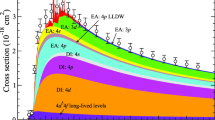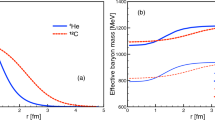Summary
The response to an ionizing radiation field of a simple one-electron atomic system modelled by an attractive Fermi-type pseudopotential is investigated under the assumption that the source intensity is sufficiently low for a perturbation theory treatment at appropriate order to be adequate in dealing with the radiation field-matter interaction. One- and two-photon ionization cross-sections are evaluated either in the length or in the velocity forms by using an approach recently put forward by the authors, which stresses the nature of such quantities as Fourier transforms of relevant time-dependent correlation functions. Some remarks concerning the merits of different gauges in approximate two-photon ionization cross-section calculations conclude the paper.
Riassunto
Un approccio recentemente suggerito dagli autori, che sottolinea la struttura formale delle sezioni efficaci di ionizzazione multifotoniche quali trasformate di Fourier di appropriate funzioni di correlazione dipendenti dal tempo, è applicato in dettaglio al caso di processi indotti in un semplice atomo modello monoelettronico, assumendo un potenziale effettivo attrattivo tra elettrone ottico e gusci interni del tipo pseudopotenziale di Fermi. Sezioni efficaci di ionizzazione per assorbimento di uno o due fotoni, nelle condizioni di validità di un regime perturbativo, sono calcolate nelle forme standard «lunghezza» e «velocità», in modo da porre in evidenza l’indipendenza dal gauge scelto dei risultati ottenuti. Il ruolo del gauge in calcoli di tipo approssimato è brevemente esaminato alla luce dei risultati forniti da modello studiato.
Similar content being viewed by others
References
Perturbation theory at large order is to be pointed out as a very active field of research. As a readable, very authoritative reference in this broad area we limit ourselves to quote theProceedings of the International Workshop on Perturbation Theory at Large Order, appeared inInt. J. Quantum Chem.,21, issue No. 1 (1982). A few references which are more relevant to the specific content of our paper are the following:a)F. V. Bunkin andI. I. Tugov:Phys. Rev. A,8, 601 (1973);b)F. H.M. Faisal:Nuovo Cimento B,33, 775 (1976);c)P. Lambropoulos: inAdvances in Atomic Molecular Physics, edited byD. R. Bates andB. Bederson, Vol.12 (Academic Press, New York, N. Y., 1976), p. 87;d)S. Yeh andP. Stehle:Phys. Rev. A,15, 213 (1977);e)L. Mower:Phys. Rev. A,22, 882 (1980);f)Y. Gontier, N. K. Rahman andM. Trahin:Nuovo Cimento D,4, 1 (1984).
The application of the time-honoured gauge-invariance principle in quantum mechanics has stirred a lot of attention in recent years, especially in the context of deriving correct transition probabilities between quantum states. Here is a selection of relevant papers:K.-H. Yang:Ann. Phys. (N. Y.),101, 62 (1976);C. Cohen-Tannoudji, B. Diu andF. Laloë:Quantum Mechanics (John Wiley and Sons, New York, N. Y., 1977), p. 315;J. J. Forney, A. Quattropani andF. Basani:Nuovo Cimento B,37, 78 (1977);D. H. Kobe:Phys. Rev. Lett. 40, 538 (1978);D. H. Kobe andA. L. Smirl:Am. J. Phys.,46, 624 (1978);C. Leubner andP. Zoller:J. Phys. B,13 3613 (1980);C. Leubner:Am. J. Phys.,49, 738 (1981);Y. Aharonov andC. K. Au:Phys. Lett. A,86, 269 (1981);K.-H. Yang:Phys. Lett. A,92, 71 (1982);J. Bergou:J. Phys. B,16, L647 (1983).
There exists a real plenty of material scattered through the literature. We limit here ourselves to quote one book and three collections of papers appeared in the past few years:M. H. Mittleman:Introduction to the Theory of Laser-Atom Interactions (Plenum Press, New York, N. Y., 1982);Photon-Assisted Collisions and Related Topics, edited byN. K. Rahman andC. Guidotti (Harwood Acad. Publ., Chur, London, New York, N. Y., 1982);Collisions and Half-Collisions with Lasers, edited byN. K. Rahman andC. Guidotti (Harwood Acad. Publ., Chur, London, New York, N. Y., 1984);J. Phys. (Paris) Colloq.,46 C1 (1985).
I. J. Berson:J. Phys. B.,8, 3078 (1975);b)T. T. Wu: inResonances-Models and Phenomena, Lecture Notes in Physics, Vol.211, edited byS. Albeverio, L. S. Ferreira andL. Streit (Springer, Berlin, 1984), p. 293.
G. P. Arrighini, F. Biondi andC. Guidotti:J. Phys. B, to appear.
A. Grossmann, R. Hoegh-Krohn andM. Mebkhout:J. Math. Phys.,21, 2376 (1980).
M. Gell-Mann:Nuovo Cimento,4 (Suppl. 2), 848 (1956).
a)S. T. Epstein,J. Chem. Phys.,42, 2897 (1965);b)A. F. Starace:Phys. Rev. A,3, 1242 (1971);c)D. H. Kobe:Phys. Rev. A,19, 1876 (1979);d)D. Lee andA. C. Albrecht:J. Chem. Phys.,78, 3382 (1983).
See, for example,A. Messiah:Mécanique Quantique (Dunot, Paris, 1959).
G. Baym Lectures on Quantum Mechanics (Benjamin, New York, N. Y., 1969).
K. Gottfried:Quantum Mechanics, Vol.I (Benjamin, New York, N. Y., 1966), p. 463.
a)D. Park:Introduction to Strong Interactions (Benjamin, New York, N. Y., 1966), p. 78;b)R. D. Levine:Quantum Mechanics of Molecular Rate Processes (Oxford University Press, Oxford, 1969), p. 70.
B. J. Berne andG. D. Harp: inAdvances in Chemical Physics, Vol.17, edited byI. Prigogine andS. A. Rice (Interscience, New York, N. Y., 1970), p. 63.
R. Gordon: inAdvances in Magnetic Resonances, Vol.3, edited byJ. S. Waugh (Academic Press, New York, N.Y., 1968), p. 1.
E. J. Heller:J. Chem. Phys.,64, 63 (1976).
R. P. Feynman andA. R. Hibbs:Quantum Mechanics and Path Integrals (McGraw-Hill, New York, N. Y., 1965).
W. Rodhes:Chem. Phys.,22, 95 (1977);S. Mukamel andJ. Jortner: inExcited States, Vol.3, edited byE. C. Lim (Academic Press, New York, N. Y., 1977), p. 57.
J. Morellec, D. Normand andG. Petite: inAdvances in Atomic and Melecular Physics, Vol.18, edited byD. R. Bates andB. Bederson (Academic Press, New York, N. Y., 1981), p. 97.
S. A. Adelman:Phys. Rev. A,5, 508 (1972);J. Phys. B,6, 1986 (1973).
S. Geltman:Phys. Lett.,4, 168 (1963).
J. G. Cordes andM. G. Calkin:J. Phys. B,13, 4111 (1980);C. K. Au:Am. J. Phys.,50, 260 (1982);J. G. Cordes andM. G. Calkin:Am. J. Phys.,51, 665 (1983).
Author information
Authors and Affiliations
Additional information
To speed up publication, the authors of this paper have agreed to not receive the proofs for correction.
Rights and permissions
About this article
Cite this article
Arrighini, G.P., Guidotti, C. & Durante, N. One- and two-photon ionization of model atoms. Il Nuovo Cimento D 7, 559–579 (1986). https://doi.org/10.1007/BF02450496
Received:
Issue Date:
DOI: https://doi.org/10.1007/BF02450496




